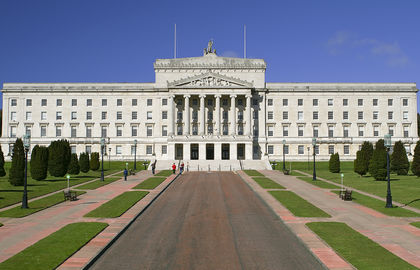Ireland hosts a parliamentary democracy. The president serves a term of seven years, as elected by the people, and is considered the guardian of the country's constitution. The Parliament is known as the Oireachtas, and is divided into two houses. The first is the Dáil Éireann, or the House of Representatives, and the latter is the Seanad Éireann, or the Senate. Ireland's government also includes the prime minister, who holds executive power, the deputy prime minister, and the minister of finance.
 |
The Irish Parliament House |
In terms of justice, the President appoints all judges, who serve until death or retirement unless removed from office by the Oireachtas. There is a Supreme Court, as well as a High court and several circuit and district courts. In 1972, the country even established a special criminal court for cases involving terrorism.
Equal gender representation in government is nonexistent in Ireland, but the country has elected two female presidents in the past: Mary Robinson (1990) and Mary McAleese (1997). There have recently been calls for quotas in the Oireachtas so women can obtain more representation.
There are four major political parties in Ireland.
1. Fianna Fáil: This Republican Party was founded by Eamon de Valera, a former prime minister and president of Ireland. This party is currently in power. It adopts centrist, pro-business policies, but lost some popularity after Ireland's property bubble burst.
2. Fine Gael: This party of Irish nationalists founded the Irish Free State. This party was in power from 1922-1932. After World War II, the power tended to shift toward the Fianna Fáil. The Fine Gael has been out of power since 1987, but the distinctions between this parry and the Fianna Fáil have become increasingly blurred over the years.
3. The Labour Party: This party used to be seen as a minor coalition, battling the oppression and hegemony of the Fianna Fáil and Fine Gael. For the first time in history, however, opinion polls place it ahead of these two major parties.
4. Sinn Féin: This anti-big business party originally gained its popularity in Northern Ireland, but has begun to set its sights on the Republic for more political power.
Sources:
Boland, F., Edwards, R.W.D., Kay, S., Ranelagh, J. O., Abhinav, V., Albert, M., ... Young, G. (n.d.). Ireland. Encyclopædia Britannica. Retrieved from http://www.britannica.com/EBchecked/topic/293754/Ireland
Crowley, J. (2010). A Guide to Ireland's Political Parties. Retrieved from http://blogs.wsj.com/dispatch/2010/11/23/a-guide-to-irelands-political-parties/
Toscano, J. (n.d.). [Photograph of Irish Parliament House]. Retrieved from http://www.nationsencyclopedia.com/Europe/Ireland-POLITICAL-PARTIES.html#b
No comments:
Post a Comment